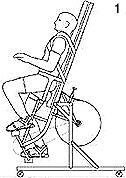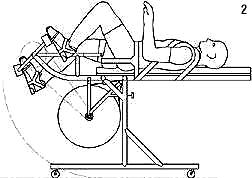1994 Project Reports | Contents | Previous | Next | Home |
The Tiltcycle: a therapeutic assessment and exercise device
David Brown, PT, PhD; Christine Dairaghi, BS; Douglas Schwandt, MS
Objectives - The Tiltcycle is a modified ergometer that allows patients with lower extremity movement deficits to pedal safely in a variety of inclinations from supine to upright (Figures 1, 2). It can provide therapeutic exercise for a wide range of patients, including those with stroke, head injury, multiple sclerosis, post-polio, and amputation. In particular, it can be used by patients who are non-ambulatory or pre- ambulatory, allowing their rehabilitation to begin earlier. The Tiltcycle can also provide an objective assessment of the patient's biomechanical deficiencies. It thus bridges the gap between the traditional subjective visual methods for assessing lower extremity movement and the expensive electronic motion analysis systems.
 Figure 1. The tiltcycle, upright position. |
 Figure 2. The tiltcycle, supine position. |
Approach - The Tiltcycle has been designed to be a safe and practical clinical tool. A secure strapping system provides postural stability at all tilts and reduces hip sway, as well as stabilizing the ankle and the foot. The ergometer workload and the body orientation can be easily adjusted to meet a particular patient's requirements. A limb platform allows the patient to pedal using either one or both legs.
Information about the position, velocity, and acceleration of the crank is monitored and can be used to assess the patient's capabilities and to guide his or her treatments. For example, we may initially observe that a patient slows down considerably at a particular point in the crank cycle. During treatment, we provide feedback about crank acceleration to the subject, so that he or she can work on pedaling through the entire cycle as smoothly as possible. We observe that improvements in the smoothness of pedaling lead to improvements in the smoothness of walking.
Status - We have been clinically evaluating a laboratory version of the Tiltcycle over the past two years, and we are now designing a clinical version. Our studies confirm that pedaling is an effective exercise for improving strength, endurance, and range of movement in many rehabilitation patients. They suggest that pedaling may also prove to be an effective treatment for improving motor control in patients with brain injuries. We believe that the therapeutic effects of pedaling and the sensitivity of movement assessment based on pedaling are both enhanced when performed under a variety of conditions such as at different body orientations, or using either one or both legs. In this way the Tiltcycle enables the patient to practice movements under diverse conditions such as are likely to be encountered in the real world.
Republished from the 1994 Rehabilitation R&D Center Progress Report. For
current information about this project, contact David Brown.